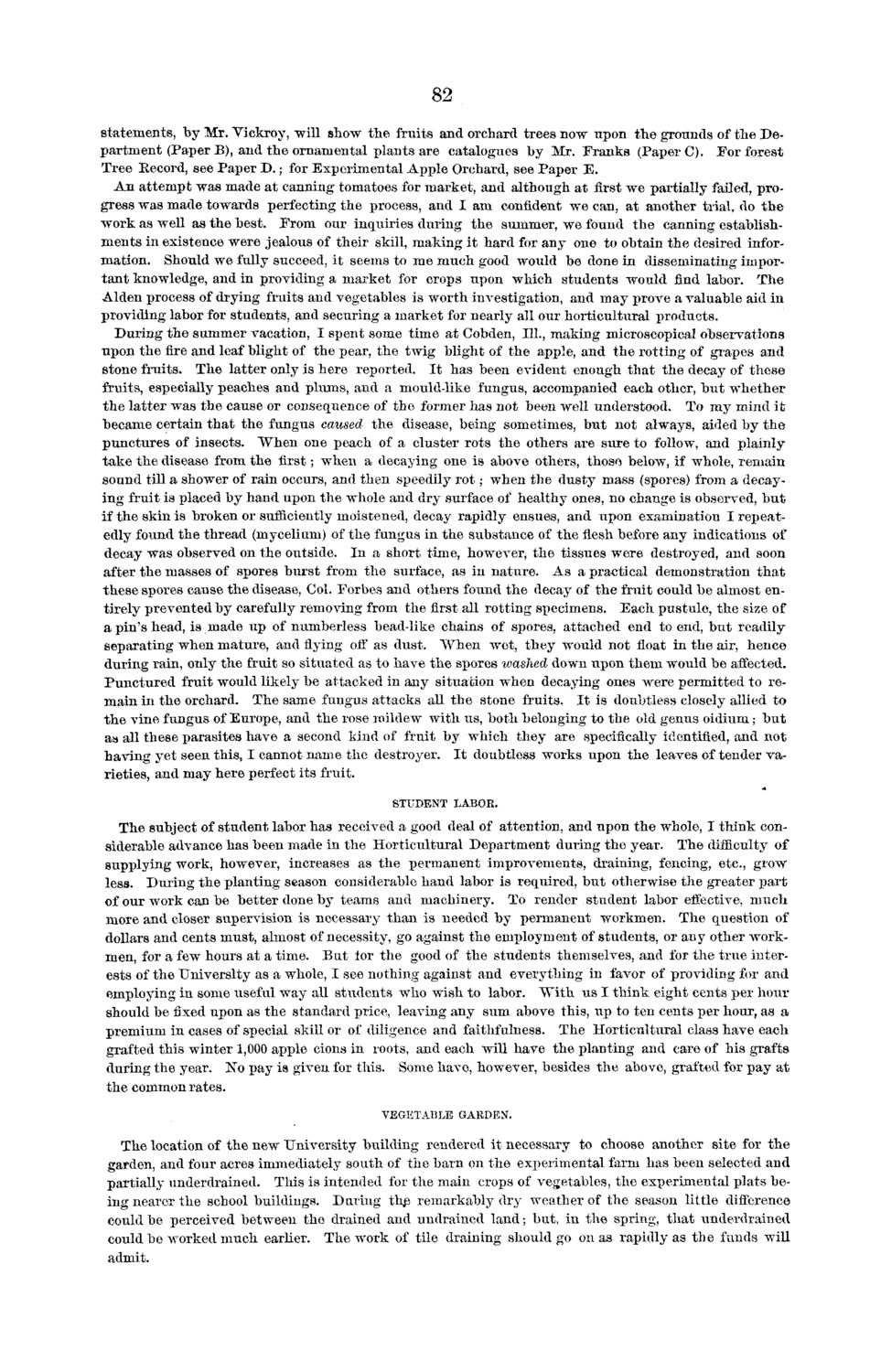| |
| |
Caption: Board of Trustees Minutes - 1872
This is a reduced-resolution page image for fast online browsing.

EXTRACTED TEXT FROM PAGE:
82 statements, by Mr. Vickroy, will show the fruits and orchard trees now upon the grounds of the Department (Paper B), and the ornamental plants are catalogues by Mr. Franks (Paper C). For forest Tree Kecord, see Paper D.; for Experimental Apple Orchard, see Paper E. An attempt was made at canning tomatoes for market, and although at first we partially failed, progress was made towards perfecting the process, and I am confident we can, at another trial, do the work as well as the best. From our inquiries during the summer, we found the canning establishments in existence were jealous of their skill, making it hard for any one to obtain the desired information. Should we fully succeed, it seems to me much good would be done in disseminating important knowledge, and in providing a market for crops upon which students would find labor. The Alden process of drying fruits and vegetables is worth investigation, and may prove a valuable aid in providing labor for students, and securing a market for nearly all our horticultural products. During the summer vacation, I spent some time at Cobden, 111., making microscopical observations upon the fire and leaf blight of the pear, the twig blight of the apple, and the rotting of grapes and stone fruits. The latter only is here reported. I t has been evident enough that the decay of these fruits, especially peaches and plums, and a mould-like fungus, accompanied each other, but whether the latter was the cause or consequence of the former has not been well understood. To my mind it became certain that the fungus caused the disease, being sometimes, but not always, aided by the punctures of insects. When one peach of a cluster rots the others are sure to follow, and plainly take the disease from the first; when a decaying one is above others, those below, if whole, remain sound till a shower of rain occurs, and then speedily r o t ; when the dusty mass (spores) from a decaying fruit is placed by hand upon the whole and dry surface of healthy ones, no change is observed, but if the skin is broken or sufficiently moistened, decay rapidly ensues, and upon examination I repeatedly found the thread (mycelium) of the fungus in the substance of the flesh before any indications of decay was observed on the outside. In a short time, however, the tissues were destroyed, and soon after the masses of spores burst from the surface, as in nature. As a practical demonstration that these spores cause the disease, Col. Forbes and others found the decay of the fruit could be almost entirely prevented by carefully removing from the first all rotting specimens. Each pustule, the size of a pin's head, is made up of numberless bead-like chains of spores, attached end to end, but readily separating when mature, and flying off as dust. "When wet, they would not float in the air, hence during rain, only the fruit so situated as to have the spores washed down upon them would be affected. Punctured fruit would likely be attacked in any situation when decaying ones were permitted to remain in the orchard. The same fungus attacks all the stone fruits. I t is doubtless closely allied to the vine fungus of Europe, and the rose mildew with us, both belonging to the old genus oidium; but as all these parasites have a second kind of fruit by which they are specifically identified, and not having yet seen this, I cannot name the destroyer. I t doubtless works upon the leaves of tender varieties, and may here perfect its fruit. STUDENT LABOR. The subject of student labor has received a good deal of attention, and upon the whole, I think considerable advance has been made in the Horticultural Department during the year. The difficulty of supplying work, however, increases as the permanent improvements, draining, fencing, etc., grow less. During the planting season considerable hand labor is required, but otherwise the greater part of our work can be better done by teams and machinery. To render student labor effective, much more and closer supervision is necessary than is needed by permanent workmen. The question of dollars and cents must, almost of necessity, go against the employment of students, or any other workmen, for a few hours at a time. But lor the good of the students themselves, and for the true interests of the University as a whole, I see nothing against and everything in favor of providing for and employing in some useful way all students who wish to labor. With us I think eight cents per hour should be fixed upon as the standard price, leaving any sum above this, up to ten cents per hour, as a premium in cases of special skill or of diligence and faithfulness. The Horticultural class have each grafted this winter 1,000 apple cions in roots, and each will have the planting and care of his grafts during the year. No pay is given for this. Some have, however, besides the above, grafted for pay at the common rates. VEGETABLE GARDEN. The location of the new University building rendered it necessary to choose another site for the garden, and four acres immediately south of the barn on the experimental farm has been selected and partially underdrained. This is intended for the main crops of vegetables, the experimental plats being nearer the school buildings. During th£ remarkably dry weather of the season little difference could be perceived between the drained and undrained land; but, in the spring, that underdrained could be worked much earlier. The work of tile draining should go on as rapidly as the funds will admit.
| |